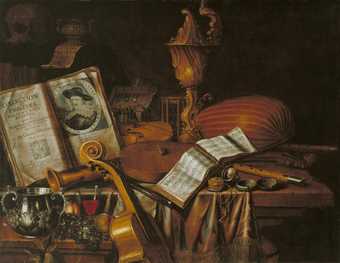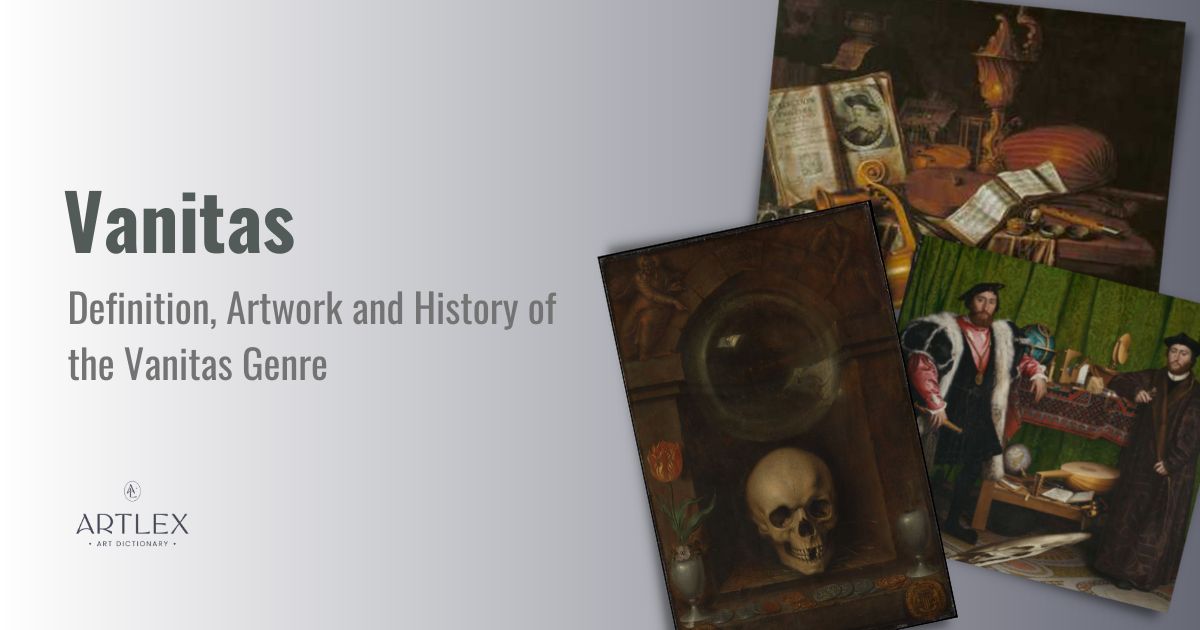What is Vanitas?
In Western art, vanitas painting is a genre of still life artwork that is intended to remind the viewer of the transience of life and the worthlessness of earthly pleasures. Vanitas paintings remind viewers of their own mortality by including objects symbolic of both life and death, such as skulls, lit and extinguished candles, books, wilted flowers, wine, and musical instruments.
Notable Vanitas Artwork



History of Vanitas
In the Dutch Golden Age of the 17th century, vanitas painting emerged as a tradition in Dutch still life painting. Vanitas paintings are typically very realistic still lives that sometimes include figures. Vanitas still life painting flourished in the Netherlands as Dutch painters reacted to the rise in wealth at the time. Vanitas painting intended to communicate the fleeting, temporary, and finite nature of life using common and recognizable symbols.
The term vanitas, however, is of Latin origin and is related to the first two lines of the Old Testament’s Book of Ecclesiastes in the Bible: “Vanitas vanitatum … et omnia vanitas” (Ecc. 1:2), meaning “Vanity of vanities…all is vanity.” Vanitas paintings emphasized the vanity of worldly pleasures and the eternal nature of the afterlife. In a sense, this “vanity of vanities” was seen as a disruption of spirituality and even a flaw in humanity.
While vanitas paintings are known to be impressively detailed pieces, the early versions of vanitas paintings were not always in full view. Before the late Renaissance, vanitas paintings appeared as simple renderings of skulls and similar symbols on the rear side of portraits. It was only later, around the mid-16th century, that vanitas became a genre in its own right.
Vanitas Symbols and Themes
Vanitas still life paintings comment on the fleeting nature of worldly goods and the inevitability of death through objects that function symbolically. Standard elements in vanitas paintings, usually reflecting wealth and death, include books, playing cards, maps, wilting flowers, fruit, goblets of wine, jewellery, hourglasses, skulls, and recently extinguished candles. There are also symbols of eternal life and resurrection, such as laurel leaves, sprigs of ivy, and ears of corn. Each symbol carries a moralistic message that encourages the viewer to consider their own mortality and how they live their lives.
The symbol of the book traditionally alludes to excessive pride through learning. The wine jug alludes to the momentary nature of certain pleasures, such as overindulgence in food and wine. The skull is a memento mori, a reminder that death is inevitable. The hourglass is a reminder of time passing. The wilted flower, another symbol of death and decay. These vanitas symbols also convey the sense that excessive wealth, and therefore vanity, is in no way an escape from death and final judgement. Material possessions were meaningless so long as life was brief.
Vanitas painting was approached two ways: the first being hopeful for the afterlife and the second being rooted in the present. The more hopeful approach compares the vain nature of mortal life to the possibility of eternal life. The second approach focuses on the pleasure that earthly goods and experiences bring while one is still living. The overall message within the vanitas theme is to enjoy the present with the understanding that it can all change in an instant.
The symbolic objects used in vanitas paintings were also nuanced and give clues as to the location where the piece was created. Leiden, Netherlands was (and still is) home to a university and therefore the artists working in and near Leiden would typically include stacks of books in their vantias works. Leiden was also an art hub for many Dutch painters.
While vanitas paintings with figures are less common than object-based still lifes, they make use of the same symbols to give the viewer information about the subject. Hans Holbein the Younger demonstrates this in the painting The Ambassadors from 1533. Holbein the Younger tells the story of the French ambassador of England and the Bishop of Lavaur, who are depicted leaning against a shelf laden with what would later become staple symbols of the vanitas tradition. A globe and other navigation tools show that the subjects are worldly and well-travelled, while musical instruments and gold jewellery attest to education, wealth, and leisure.
Vanitas and Religion
Vanitas still life painting carried a moralistic message and religious reminder of the afterlife. The Protestant reformation, which occurred in the 16th century, amplified the clash between Catholic and Protestant values and was influential upon the vanitas theme. Dutch artists communicated their Protestant affiliations and overall religious sentiments through vanitas artwork.
Unlike other European artwork at the time, the symbol and allegory known to vanitas painting reflected Protestant themes and ethics rather than Catholic allegories. In the vanitas informed by Protestantism, the mysteries of saints were replaced by the certainty of death. Vanitas still life painting conveyed the spiritual through mundane, everyday objects rather than religious icons. The intricacy of vanitas painting reflects a commitment to realism and the spiritual connection between Heaven and Earth. However, vanitas paintings and Catholic art both encouraged viewers to act in accordance with God rather than to overindulge in material delights.
Later Developments in Vanitas Painting
The original vanitas movement hit its peak in the mid-17th century, however, many artists throughout the history of Western modern art continued to explore the brevity and exuberance of life. The interrogation of complex topics through objects continued in the tradition of still life painting.
Skulls are simply one symbolic object that appear in countless paintings from the works of Pablo Picasso and Paul Cézanne to Roy Lichtenstein and Andy Warhol. Dutch artist Vincent van Gogh’s Head of a Skeleton with a Burning Cigarette from 1886 goes so far as to turn a common and stark symbol of vanitas upside down. van Gogh’s dark and painterly composition features a bust of a skeleton smoking a cigarette. A twist on the typically solitary skull seen in 17th century Dutch vanitas painting, this skeleton almost seems animated as it partakes in a widespread, mundane vice that was popular at the time.
Despite the inherent morbidity of representations of death and decay, vanitas painting still carries the legacy of hopeful aspirations beyond life itself.
Notable Vanitas Artists
- Jacques de Gheyn the Elder, 1565-1629, Dutch
- Pieter Claesz, 1597-1660, Dutch
- Willem van Aelst, 1627-1683, Dutch
- Paul Cézanne, 1839-1906, French
- Vincent van Gogh, 1853-1890, Dutch
- Joris van Son, 1623-1667, Flemish
- Hans Holbein the Younger, 1497-1543, German
- Jan Miense Molenaer, 1610-1668, Dutch
- David Bailly, 1584–1657, Dutch
- Harmen van Steenwyck, 1612–1656, Dutch
- Willem Claesz Heda, 1594–1681, Dutch
Related Art Terms
- Still Life
- Iconography
- Memento mori

